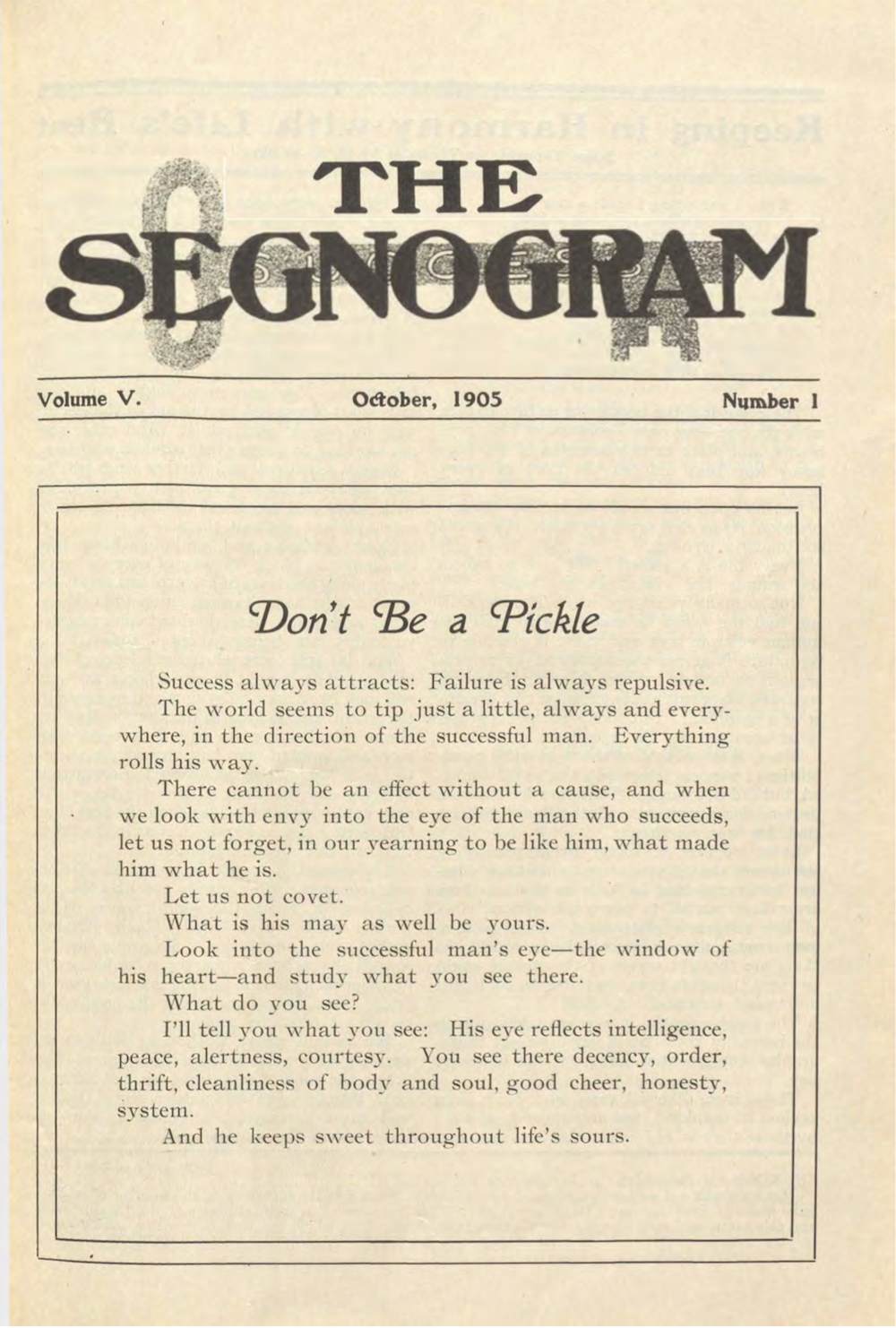

|
| About | Archives | Practices | Contribute | Contacts | Search |
| Periodical: | The Segnogram |

|
|
| Summary: |
From Pat Deveney's database:
Segnogram, The. The advertisement for the journal in Henry Milton Walker's The Heart of Things (published by Segnogram Publishing Company in 1906) claimed that the journal was "the largest and best magazine devoted to the development of the mental and physical and the acquirement of success and health through correct living. It contains more useful information than the average magazine sold for one dollar, but the price of [the journal] will remain at 50 cents a year." Victor Segno (William Albert Hall, 1870-?) was one of the most successful of the New Thought hucksters. Photographs of Segno ("in response to many requests") appeared regularly in the journal and show him to have been a tall man with wavy hair and a compelling look in his eyes. He first appeared in Los Angeles about 1902 working as a chiropractor, hypnotist and palmist and then realized his true calling as a mail-order mage. In his early years in Los Angeles he was associated with E. Victor Neal (Xenophon Lamotte Sage) in the Columbia Scientific Academy, as Marc Demarest has discovered, an institute designed to provide credentials to those in the New Thought business, and after Sage left for Rochester to establish the New York Institute of Science he continued to advertise in this journal. If Segno had an underlying philosophy it seems to have been that thought can generate etheric energy in the brain--if the brain was properly trained in his methods and fed with suitable food chosen in accordance with his ideas. "Mentalism is the harmonious action of the three most powerful faculties of the mental organization. The first of these is Thought, the second, Etheric Energy, and the third is Will. Thought is the intelligence which is collected by the brain for the use of the mind, from such passing mental vibrations as are in harmony with it. Etheric Energy is the force generated in the brain by the process of thinking. It is upon this force that thoughts travel from the cells of the brain to their destination. The Will is the operator and director and dispatches and guides the thoughts to their respective stations. Thus, Thought conveyed by Etheric Energy, and guided and controlled by Will, becomes a power of such magnitude that neither material nor distance is a barrier to its transmission." The journal was essentially a prolonged advertisement for his Segno Success Clubs, Life Culture Society ("You Can Live 100 Years"--and renew youth, health and beauty), American Institute of Mentalism ("Learn to Send Telepathic Messages"), free character readings, courses in graphology, and his various books, pamphlets and lessons ("How to be Happy Tho' Married," The Law of Mentalism, The Secret of Memory, etc.), which were translated into all the major European languages, as well as into Armenian and Russian). To avoid the strictures of the postal laws the journal had a large amount of "filler," articles of general interest, especially on the wonders of California real estate and California olives (in both of which Segno had an interest), a joke column ("Smiles"), and business success nostrums, and featured articles on diet ("Health-Giving Food," by Segno's then wife), "Aids to Feminine Beauty" by the aptly named "A.G. Irl"), graphology, as well as the usual poems and articles by Ella Wheeler Wilcox and contributions by G.A. Mann (on New Thought), Camille Flammarion, William Towne, and, beginning in 1905, William Walker Atkinson, who became co-editor of the journal the next year after his short-lived journal the Mystic failed. Segno's American ventures came crashing down when he ran off with his secretary in 1911, both of them being married to others at the time. He turned up in Germany (and then Russia) before World War I and continued his enterprises, all with astonishing success. He returned to the United States in 1915, but his wife seems to have gotten possession of his businesses in Los Angeles. The publishing company was bought out by new owners in 1912. The journal was said to have been the predecessor of Opportunity. LOC. |
| Issues: | Segnogram V3 N1 Oct 1904 |
| Segnogram V3 N2 Nov 1904 | |
| Segnogram V3 N3 Dec 1904 | |
| Segnogram V3 N4 Jan 1905 | |
| Segnogram V3 N5 Feb 1905 | |
| Segnogram V3 N6 Mar 1905 | |
| Segnogram V4 N1 Apr 1905 | |
| Segnogram V4 N2 May 1905 | |
| Segnogram V4 N3 Jun 1905 | |
| Segnogram V4 N4 Jul 1905 | |
| Segnogram V4 N5 Aug 1905 | |
| Segnogram V4 N6 Sep 1905 | |
| Segnogram V5 N1 Oct 1905 | |
| Segnogram V5 N2 Nov 1905 | |
| Segnogram V5 N3 Dec 1905 | |
| Segnogram V5 N6 Mar 1906 | |
| Segnogram V6 N1 Apr 1906 | |
| Segnogram V6 N2 May 1906 | |
| Segnogram V6 N3 Jun 1906 | |
| Segnogram V6 N4 Jul 1906 | |
| Segnogram V6 N5 Aug 1906 | |
| Segnogram V6 N6 Sep 1906 | |
| Segnogram V7 N1 Oct 1906 | |
| Segnogram V7 N2 Nov 1906 | |
| Segnogram V7 N3 Dec 1906 |
|
|